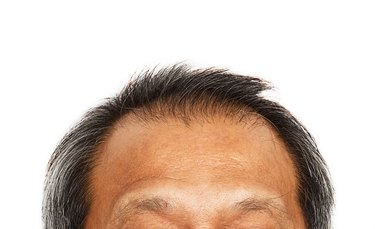
Iron deficiency can cause thinning hair, but other diseases and conditions can instigate hair loss, too. Hormonal changes, thyroid disorders, heredity, diabetes, lupus, inadequate protein, ringworm and certain medications can prompt noticeable shedding. To confirm whether you have low iron, your physician should order a blood test to check your ferritin, hemoglobin and/or hematocrit concentrations. Until you consult with your doctor and receive a diagnosis of iron-deficiency anemia, don't take over-the-counter iron supplements. Overzealous supplementation may lead to tissue damage, fibrosis and an increased risk of colorectal cancer, according to the May 2006 issue of the "Journal of the American Academy of Dermatology."
Step 1
Treat iron-deficiency anemia with 300 milligrams of ferrous sulfate twice daily, or follow your doctor's recommended dosage. Because the caplets aren't pure iron, each 300 milligrams dose of ferrous sulfate contains only 60 milligrams of elemental iron. The Centers for Disease Control and Prevention recommends 60 to 120 milligrams of elemental iron each day for women and teenagers with iron-deficiency anemia, including pregnant women, until iron stores are replenished. Physicians prescribe lower doses for infants and children and rarely recommend iron supplements for adult males and postmenopausal women.
Video of the Day
Step 2
Request an alternative recommendation from your doctor if ferrous sulfate's side effects prove unbearable. Because salt-based iron compounds sometimes cause gastrointestinal upset, constipation and vomiting, extended-release or liquid formulations may work better for you.
Step 3
See your health care provider to re-evaluate your iron level after four weeks of following your supplement regimen. If your hemoglobin concentration has improved, your doctor will likely recommend continuing the treatment for up to six months.
Step 4
Monitor your iron concentration on a yearly basis if you've been diagnosed with iron-deficiency anemia. Women of childbearing age are most at risk for repeat bouts. To promote hair growth, the Cleveland Clinic Foundation suggests that patients keep a ferritin concentration of at least 70 nanograms per milliliter.
Step 5
Prevent iron deficiency from occurring or recurring by consuming the recommended amount of iron from food sources. One bowl of iron-fortified cereal can provide up to 18 milligrams of iron. Other foods high in iron include spinach, beans, lentils, soybeans, chicken liver, lean beef and oysters. Children, teenage boys and men need 11 and 8 milligrams of iron per day, respectively, while teenage girls require 10 milligrams and adult women need 18 milligrams per day. Pregnant women need 30 milligrams of iron per day and should take prenatal supplements that contain iron with their doctors' guidance. Vegetarians of all ages should aim for 1.8 times more iron than the recommended daily allowance, as iron from plant sources enters the bloodstream at a lower rate.
Tip
If you’re a competitive athlete, you may need up to 30 percent more iron than the general population. Long-distance runners, athletic women and vegetarians should pay close attention to their hemoglobin concentration, according to the U.S. Office of Dietary Supplements. Drink orange juice or take vitamin C with your iron supplement to increase its absorption rate.
Warning
Calcium, tea and coffee reduce the absorption rate of iron. Avoid consuming dairy products, tea, coffee, antacids and calcium supplements within two hours of ingesting iron supplements.
Video of the Day